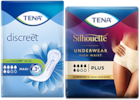During this time, tampons are off limits. That’s because it takes weeks for your uterus to contract back to its normal size, and inserting a tampon could introduce bacteria and increase the chances of an infection. You may also have some perineal tears in and around your vagina, which could get infected or scraped by an inserted tampon, so, it’s best to use postpartum pads instead. It's also recommended to have showers at this time, rather than baths.
For the first week or two after birth, it’s a good idea to have some post-partum underwear or pads that offer maximum absorbency levels, in case you experience a loss of bladder sensation and find that you wet yourself because you don’t feel the urge to urinate.
You might be tempted to use regular sanitary pads, but these may not give you the levels of absorption that you need. Proper postpartum pads like TENA Sensitive Care Ultimate Long Pads are thicker and longer than normal pads, which also help to cushion any areas that might be extra sore.
Immediately after birth, you might find that you’re most comfortable wearing disposable underwear. They can give a feeling of security around the tummy, whilst offering maximum absorption and protection. TENA Super Plus Heavy Underwear features a stylish, cottony-soft fabric, and is form-fitting and designed to look and feel like regular underwear with triple protection against bladder leaks, urine odor, and wetness.
As the bleeding and any leaks become less heavy, you may want to switch over to wearing post-partum pads in your own underwear. TENA Sensitive Care Extra Coverage Maximum Long Pads with 25% extra coverage* are now the first ever bladder weakness pads enriched with our SkinComfort Formula. Our triple protection against bladder leaks odor and wetness, Duolock core, and cushiony foam side barriers offer skin comfort and security.
Over time, as the bleeding stops and leaks get lighter, you can move to a liner – TENA Intimates Moderate Regular Pads are 100% breathable to help protect your sensitive, intimate skin. These pads are designed with triple protection against bladder leaks, odor, and wetness.
Or if your skin is still sensitive after childbirth, TENA Sensitive Care pads are discreet and designed to help protect your sensitive, intimate skin.






